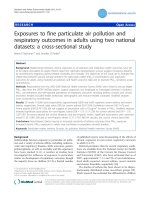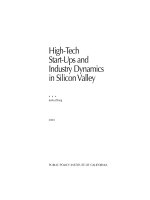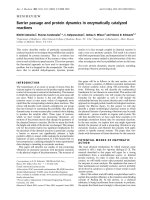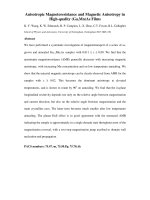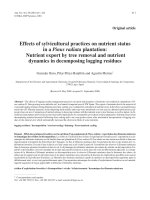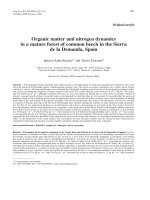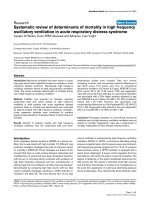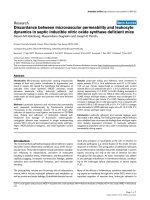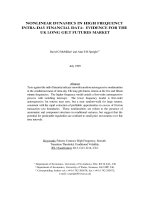mcmillan and speight-nonlinear dynamics in high frequency intra-day financial data
Bạn đang xem bản rút gọn của tài liệu. Xem và tải ngay bản đầy đủ của tài liệu tại đây (167.96 KB, 30 trang )
NONLINEAR DYNAMICS IN HIGH FREQUENCY
INTRA-DAY FINANCIAL DATA: EVIDENCE FOR THE
UK LONG GILT FUTURES MARKET
David G McMillan
1
and Alan E H Speight
2,*
July 1999
Abstract
Tests against the null of linearity indicate smooth transition autoregressive nonlinearities
in the conditional mean of intra-day UK long gilt futures returns at the five and fifteen
minute frequencies. The higher frequency model entails a first-order autoregressive
process with switching intercept. The lower frequency model is first-order
autoregressive for returns near zero, but a near random-walk for large returns,
consistent with the rapid extraction of profitable opportunities in excess of friction
transaction cost boundaries. These nonlinearities are robust to the presence of
asymmetric and component structures in conditional variance, but suggest that the
potential for predictable regularities are confined to small price movements over fine
time intervals.
Keywords: Futures Contract, High Frequency, Smooth
Transition Threshold, Conditional Volatility.
JEL Classification: G12, G13, G14, C22.
1
Department of Economics, University of St Andrews, Fife, KY16 9AL, UK
2
Department of Economics, University of Wales, Swansea, SA2 8PP, UK.
* Corresponding Author: tel: (+44) 1792-205678; fax: (+44) 1792-295872;
e-mail:
1
1. Introduction
Over the past decade and a half, the genre of models of generalised autoregressive conditional
heteroscedasticity (GARCH: Engle, 1982; Bollerslev, 1986) have provided the dominant means for
modelling nonlinear dependence in financial data, largely due to their empirical success in capturing the
time-varying conditional volatility characteristic of the returns distributions of many financial assets.
1
A
popular and theoretically appealing explanation for the presence of ARCH effects in asset returns,
embodied in the mixture of distributions hypothesis, is that returns evolve as a subordinate stochastic
process such that the distribution of returns follows a mixture of normals with changing variance, the rate
of new information arrival providing the stochastic mixing variable. Thereby, asset prices evolve at
different rates during identical intervals of time according to the flow of new information, and the
distribution of returns, when measured over fixed time intervals, appears kurtotic. As suggested by
Diebold (1986), the empirical success of ARCH-type models may then lie in their ability to capture
serially correlation in the time-series properties of the mixing variable, the flow of information.
2
In
extension of this approach, the recent examination of high-frequency intra-day data has prompted
several researchers to suggest that volatility may more accurately be characterised by heterogenous
components reflecting heterogeneous information flows (Andersen and Bollerslev, 1997a), or perhaps
the actions of heterogeneous market traders (Müller et. al., 1997).
The analysis of high frequency intra-day data also raises a further consideration. Namely, the
potential for the conditional mean process for high-frequency returns data to be more accurately
described by a non-linear process.
3
Whilst there has been extensive investigation of non-linearity in
conditional mean in many macroeconomic time series, mostly associated with increasing recognition of
the potentially asymmetric nature of the business cycle, relatively little research has been conducted
2
seeking to identify, model or explain stochastic non-linear conditional mean structure in financial market
data.
4
One reason for this is the lack of substantive linear structure in daily or lower frequency financial
data, market returns at such frequencies typically approximating random walk processes, since linear
structure is generally a prerequisite for the conduct of formal statistical tests against the null hypothesis
of linearity.
5
Moreover, a well defined non-linear conditional mean structure for security returns over
a period of a day, for example, would potentially allow informed market participants to secure
systematic profits.
6
In contrast with such lower frequency data, intra-day data affords the linear
structure which must precede consideration of non-linearity whilst not necessarily being inconsistent with
market efficiency given the short time intervals over which such processes are found to extend.
Particularly since there must exist some time interval at sufficiently high frequency over which market
prices are brought to equilibrium following disturbance due to new information, especially in the context
of the gradual dissemination of information, noise trading, or transaction costs. These rationales for the
presence of linear structure, and the latter in particular, also provide rationales for the presence of non-
linear structure. Especially that of threshold form, where the parameters of a linear model are permitted
to change through time due to a switching rule defined over past price movements relative to some
threshold value.
In the investigation of intra-day long gilt futures returns data reported here, we therefore
consider both linear and nonlinear conditional mean structures. For the latter, we adopt the smooth
transition autoregressive (STAR) model (Chan and Tong, 1986; Teräsvirta and Anderson, 1992;
Granger and Teräsvirta, 1993; Teräsvirta, 1994) which allows for differing market dynamics according
to the magnitude of returns, motivated by considerations of market frictions, such as noise trading and
transactions costs, which create a band of price movements around the equilibrium price with
3
arbitrageurs only actively trading when deviations from equilibrium become sufficiently large. Following
confirmatory preliminary tests for the presence of threshold non-linearities, STAR conditional mean
estimates are reported. The robustness of that nonlinear mean structure to the presence of ARCH
effects is examined through joint estimation under maximum likelihood using one of two extensions of
the basic GARCH framework which permit conditional variance asymmetry or heterogeneity
respectively. The former is provided by the exponential-GARCH (EGARCH) model of Nelson (1991),
which has a correspondence with the informational flow hypothesis discussed above, whilst the latter
is provided by the Engle and Lee (1993) component-GARCH (CGARCH) model, which permits the
decomposition of conditional volatility into long-run and short-run elements, in keeping with recently
advanced notions of volatility heterogeneity in intra-day financial data.
The remainder of the paper is organised as follows. In the following section we outline the
empirical models to be estimated and further discuss their properties and relationship to issues of market
dynamics. Section 3 describes the data and institutional setting from which it is drawn, provides
nonparametric kernel density estimates of the data distributions and reports the results of preliminary
tests for nonlinearity in conditional mean. Section 4 discusses issues of model specification and
evaluation, and reports conditional mean and variance estimates. Section 5 provides a summary of our
findings and their interpretation, and concludes by noting their implications for considerations of market
efficiency and the activities of market agents.
2. Models
2.1. Market Frictions, Threshold Nonlinearities and the ESTAR Model
An issue which has received much attention in the empirical finance literature of late, and which offers
4
an appealing explanation for asymmetries in market returns, is related to the phenomenon of ‘noise-
trading’. The rationale generally offered for the existence of noise trading is that it allows privately
informed traders to profitably exploit their informational advantage, without which market efficiency
would not be assured (eg. Kyle, 1985). That rationale does not, however, explain the reasons for noise
trading, on which there are differing views. Thus, noise trading may be regarded as resulting either from
rational agents trading for liquidity and hedging purposes, consistent with a fully-rational efficient-
markets perspective (Diamond and Verrechia, 1981; Ausubel, 1990a,b; Biasis and Hillion, 1994; Dow,
1995; Dow and Gorton, 1994, 1996), or as the actions of irrational (or not-fully rational) agents trading
on beliefs and sentiments that are not justified by news concerning underlying fundamentals (Black,
1986; Schleifer and Summers, 1990; De Long et. al., 1990). An interesting alternative interpretation
recently offered by Dow and Gorton (1997) suggests that delegated portfolio managers may engage
in noise trading in order to appease clients or managers who are unable to distinguish purposeful
inaction from non-purposeful inaction, as a result of which the amount of noise trading can be large
compared to the amount of hedging volume and Pareto improving.
Whatever the underlying reasons for noise trading, its existence means that profitable
opportunities will arise for privately informed and arbitrage traders. In early recognition of the potential
nonlinear consequences of such trading activities, Cootner (1962) notes that the activities of noise
traders will cause prices to hit upper or lower ‘reflecting barriers’ around equilibrium, and thus trigger
arbitrage activities by informed traders which push prices back to equilibrium. The existence and
position of such barriers will likely depend on the existence and size of market frictions such as
transactions costs, giving rise to a band of price movements around the equilibrium price with fully
rational traders only actively trading when deviations from equilibrium are sufficiently large to make
5
arbitrage trade profitable (He and Modest, 1995). Such opportunities are unlikely to be long-lived,
existing only for as long as reassessment of underlying fundamentals in the light of news may warrant.
However, while the actions of individual traders may be represented by a simple threshold model which
imposes an abrupt switch in behaviour, only if all traders act simultaneously will this also be the
observed market outcome. For a market of many traders acting at slightly different times a smooth
transition model is therefore more appropriate than a ‘heaviside’ threshold model.
In previous examinations of intra-day asset price volatility, the differenced logarithm of the asset
price has typically been modelled as a linear autoregressive (AR) process of order p, such that the asset
return, , is described by:
(1) .
In order to investigate the possibility of threshold nonlinearities due to noise trading of the form
described above, we consider the nonlinear STAR(p) generalisation of (1), expressed in general form
(Teräsvirta and Anderson, 1992; Granger and Teräsvirta, 1993) as:
(2)
where denotes a transition function defined over a transition variable, provided here by the lagged
return value, , where d is the delay parameter. One interpretation of (2) is that is described by
the linear model in the second term on some occasions, and by that process with the addition of the
potentially non-linear component in the compound third term on other occasions. Alternatively, the
6
components and may be interpreted as rendering the intercepts
and autoregressive parameters of the model time-varying, and (2) therefore as belonging to the class
of state-dependent models (Priestley, 1988). The transition function utilized here is of the exponential
form:
(3) ,
where ( is a smoothing or transition parameter and c a threshold parameter, the combination of (2) and
(3) yielding the exponential-STAR (ESTAR) model, whereby the parameters in (4) change
symmetrically about c with , such that as , , and as ,
, whilst as either (64 or (60 the model reduces to the linear AR form.
7
Thus, the ESTAR
model implies that the dynamic process for moderate returns will differ from that for larger returns,
irrespective of sign.
8
A practical problem frequently encountered in the estimation of STAR models concerns
convergence and precision in estimates of the smoothing or transition parameter, (. In particular, a
large ( value results in a steep slope for the transition function at c, and a large number of observations
in the neighbourhood of c are in principle required in order to estimate ( accurately. Consequently,
with changes in ( having only a minor effect upon the transition function, the convergence of ( can
prove problematic. A solution to this problem, suggested by Teräsvirta (1994) and adopted in
estimation here, is to scale the smoothing parameter by the variance of the transition variable,
yielding the revised transition function:
7
(3')
with appropriate adjustment required in interpretation of the resulting estimate of (.
2.2. The Exponential-GARCH (EGARCH) Model
The initial model of conditional volatility examined is the exponential GARCH (EGARCH) model of
Nelson (1991). The selection of the EGARCH model is motivated by its close relationship with the
mixture of distributions hypothesis, originally due to Clark (1973), which views the variability of security
prices as arising from differences in information arrival rates. The standard model assumes a fixed
number of traders possessing different expectations and risk profiles, resulting in different reservation
prices. Market clearing requires that the equilibrium price be the average of these reservation prices.
Information arrival then causes traders to adjust their reservation prices, which in turn causes trade,
which then changes the market price. Under the assumption that these price changes are normally
distributed, it has been demonstrated that the aggregate of price changes and traded volume are jointly
stochastic independent normals (Tauchen and Pitts, 1983; Gallant Hsieh and Tauchen, 1991). Where
information events vary over time, price changes at the daily frequency, for example, are the sum over
intra-day price changes. By appeal to the Central Limit Theorem, aggregated price changes are then
described by mixtures of independent normals, where mixing depends on the rate of information arrival.
In keeping with this framework, following Nelson (1990, 1991), the EGARCH model has lognormal
conditional variance in continuous time, with the implication that as the sampling interval becomes finer
in discrete time, the distribution of innovations approaches a conditionally normal mixture of
distributions, thereby formally linking the EGARCH and mixture of distributions approaches.
9
8
Notationally, let the asset return have an expected return (given by the conditional
expectation of either the AR or ESTAR model defined above), and conditional variance given by
, where defines the set of all information available at
time t-1. The first-order EGARCH model, which is also the appropriate empirical model order further
below, is then given by:
(4)
where the logarithimic form ensures conditional variance non-negativity without the necessity of
constraining the coefficients of the model. Regarding the coefficients of (4), the parameter captures
the volatility clustering effect that is characteristic of ARCH processes, a positive value indicating that
large (small) shocks tend to follow large (small) shocks of random sign, while the parameter captures
the degree of persistence in shocks to volatility, with half-life decay given by The
potentially asymmetric effect of positive and negative shocks on conditional variance is captured by a
non-zero value for the parameter For , responds asymmetrically to in
a piecewise linear manner: where that ratio is positive, is linear in with slope
, whilst for , is linear in with slope .
2.3. The Component-GARCH (CGARCH) Model
While the preceding EGARCH representation of volatility is based on assumed homogeneity of the
price discovery process, it has recently been suggested that intra-day returns volatility may more
9
realistically comprise heterogeneous components (eg. Andersen and Bollerslev, 1997a). Such
components may reflect differing market reactions to differing sources and types of news, or the
differing reactions of market agents with heterogeneous positions and time horizons to the same items
of news (Müller et. al., 1997). On either view, returns volatility will consequently be dominated by
transient or short-run volatility over higher data frequencies and by more persistent or long-run volatility
over lower data frequencies.
In order to examine the data for the possible presence of such components we implement the
component-GARCH model of Engle and Lee (1993) which facilitates the decomposition of volatility
into a long-run or (inter-day) component, and a short-run (intra-day) component.
10
This (necessarily
first-order) CGARCH model is given by the joint process:
(5a)
(5b)
where the forecasting error serves as the driving force for the time-dependent movement of
the long-run component, , and the difference between the conditional variance and long-run volatility,
, defines the short-run component. The initial impact of a shock to the transitory component
is quantified by ", while $ indicates the degree of memory in the transitory component, the sum of these
parameters providing a measure of transitory shock persistence. The initial effect of a shock to the
permanent component is given by N, with persistence measured by the autoregressive root, D, and
where the transitory component decays more quickly than the permanent component
10
such that the latter dominates forecasts of the conditional variance as the forecasting horizon is
extended. The conditional variance is covariance stationary provided that the permanent component
and the transitory component are both covariance stationary, as satisfied by and
respectively, while the additional restriction of non-negativity on the model parameters ensures that
is non-negative as long as is non-negative.
11
3. Data and Preliminary Diagnostics
3.1. Data and Market Background
The data analysed here consists of the prices of UK government bond (Long Gilt) futures contracts
traded on the London International Financial Futures and Options Exchange (LIFFE), which is also the
data source.
12
The Long Gilt futures contract is of interest as a heavily traded investment and hedging
instrument, the main users of which LIFFE identifies as market makers, institutional investors and issuers
of long-term debt; for purposes of hedging, investment, asset allocation, portfolio insurance and duration
adjustment, such activities being primarily driven by consideration of long-run factors and underlying
fundamentals. A further feature of the Long Gilt futures market is its low margin requirement, which
encourages a degree of short-term speculation and provides circumstances conducive to noise-trading
of the manner described in the previous section.
The sample covers the period 24th January 1992 to 30th June 1995. The contract price data,
p, is sampled at five and fifteen minute intervals and transformed to yield the returns series,
, with the overnight return excluded so as to ensure consistent time-series.
13
With
846 trading days in the sample period, this yields 80,163 observations at the five minute frequency, and
11
26,721 observations at the fifteen minute frequency.
14
As has been noted elsewhere, high frequency intra-day data is strongly characterised by high-
frequency periodicity corresponding to proximity in time to market opening and closing, macroeconomic
and other systematic news releases and other factors, and where the strength of these intra-day effects
is such that failing to adjust for them can result in misleading analysis of the dynamic dependencies in
the data (Goodhart et. al., 1993; Andersen and Bollerslev, 1997b; Guillaume et. al., 1997; Goodhart
and O’Hara, 1997). Prior to estimation, we therefore follow Andersen and Bollerslev (1997b) in
standardising returns by the mean absolute value for each intra-day time interval, at both the both five
and fifteen minute frequencies.
15, 16
Summary statistics for the data, both before and after adjustment
by standardisation, including measures of central tendency, skewness, kurtosis, tests of normality, and
selective correlogram values for the levels and squares of the series, are reported in Table 1. Self-
evidently, adjustment increases the range and standard deviation of the underlying series, which has the
indirect benefit of aiding parameter convergence in estimation. Otherwise the basic properties of the
date are little affected. The distributional properties of the adjusted data are further illustrated in Figure
1, which depicts the results of nonparametric Epanechnikov kernel density estimation for both data
frequencies, where bandwidth selection is determined according to the data-based criteria of Silverman
(1986). The ‘peakedness’ relative to the normal indicated by the kurtosis statistics in Table 1 is clearly
obvious in both distributions, and further motivates the consideration of GARCH processes below.
Additionally evident are the ‘peaked shoulders’ in the distributions, also present in the comparable
distributions of the unadjusted data, and most pronounced in the fifteen minute frequency data, which
suggests a concentration of data points a margin either side of the zero mean, and more so on the upper
side of the distribution. This property further suggests to us the influence of significant market frictions,
12
such that beyond small return values a range of price changes become more pronounced and numerous,
and reinforces our consideration of threshold models able to accommodate this feature below. Before
proceeding to the estimation of such models, however, we first consider formal statistical tests for the
presence of such nonlinearities.
3.2. Preliminary Diagnostics
The specification of preliminary linear AR(p) models is determined by reference to the autocorrelation
and partial autocorrelation functions, the Schwarz criterion, the estimated log-likelihood, and residual
tests for serial correlation.
17
This identification procedure indicates that an AR(2) process is
appropriate at the five minute frequency, whilst an AR(1) model is appropriate at the fifteen minute
frequency. Model estimates for these specifications are reported in the first column of results in Tables
2 and 3 respectively. At both frequencies, autoregressive parameters are negative and significant,
parameter values confirming the absence of long-lived persistence or drift in returns.
18
Given appropriately specified AR models, we test for the presence of conditional mean
nonlinearity following the procedure detailed in Teräsvirta and Anderson (1992), Granger and
Teräsvirta (1993) and Teräsvirta (1994). This entails testing for threshold nonlinearities against the null
of linearity over a range of suitable possible values for the delay parameter d. The corresponding LM-
type test of AR(p) linearity assuming known d is equivalent to the test of the null hypothesis of linearity
( ), against the alternative in the following artificial regression:
(6)
13
The test statistic, computed as where T denotes the sample size,
the sum of squared residuals from the linear AR(p) model and the sum of squared residuals
obtained from (6), is asymptotically distributed as where d is unknown. Where
linearity is rejected for more than one value of the delay parameter, then d is determined such that
, where refers to the probability value at which the null of linearity is
marginally rejected.
19
Application of these tests for all possible delay values for both data
frequencies confirm rejection of the null hypothesis of linearity in favour of STAR nonlinearity with
application of the minimum rule indicating at the five minute frequency and at the fifteen
minute frequency.
20, 21
Given this diagnostic support for non-linear STAR models over linear AR
alternatives as descriptions of conditional mean structure in long gilt futures returns at frequencies of
both five and fifteen minutes, we proceed to full estimation of those models in the following section.
4. Results
4.1. Model Identification and Evaluation
Estimation of all models reported below is by iterative non-linear least squares. The validity of the
estimated models is appraised on the basis of the significance of autoregressive terms and examination
of coefficient estimates, in particular ensuring that the transition value, c, is within the range of { }. The
Akaike and Schwarz information criteria are also used to guide selection amongst competing models
(Teräsvirta, 1994). The properties of the model residuals are also examined, both for departures from
14
normality and for remaining ARCH effects. We also examine the dynamic properties of the regimes
corresponding to and by inspecting the roots of the relevant characteristic
polynomials, as well as the dynamic properties of the full models. In the absence of a general analytical
solution, the latter procedure is performed numerically, using data generated from the estimated model
after setting the error term to zero, with a sequence of observed values of the series acting as starting
values, several of the latter being considered. For the models under investigation, this may result in a
unique stable equilibrium, a limit cycle such that a set of values repeat themselves perpetually, chaotic
realisations, whereby a small change in initial values results in divergent but stable limit points, or
explosive values (in which case the model is rejected).
4.2. Nonlinear Dependence in Conditional Mean and Conditional Variance
Preliminary estimates of ESTAR models of nonlinear dependence in conditional mean alone are
reported in the fourth column of results for each frequency in Tables 2 and 3. The properties of these
models are broadly similar in terms of specification, parameter sign and magnitude to those which obtain
under joint conditional mean and conditional variance estimation, with the exception that the estimated
transition parameters are strictly statistically insignificant suggesting a degree of misspecification due to
the conditional variance structure not being modelled (though see the discussion in 2.1 above), and the
remainder of our discussion therefore focuses on jointly estimated models of nonlinear dependence in
both conditional mean and variance. ESTAR-EGARCH and ESTAR-CGARCH estimation results are
reported in the fourth and fifth columns of Tables 2 and 3, with corresponding AR-EGARCH and AR-
CGARCH estimation results reported in columns two and three of those Tables for purposes of
comparison.
15
4.2.1. Five Minute Frequency Results
At the five minute frequency, of immediate note is the reduction in model order relative to the linear
case. For the resulting ESTAR(1)-EGARCH model, the central regime corresponding to ,
which arises as , is described by an AR(1) process, whilst the outer regimes corresponding
to as invokes an additional AR(0) process.
22
Thus, there is significant
negative autocorrelation in returns irrespective of size, with the nonlinearity present being described by
a shifting intercept dependent on the magnitude of returns relative to the interval norm. The latter
specifically implies significant negative drift in returns in the neighbourhood of the threshold value, but,
on net, a tendency towards positive drift for larger returns of either sign as Both regimes
of the model are trivially stationary, and the full model is characterised by stable roots and a near-zero
unique limit point (0.0044), with rapid adjustment to equilibrium within approximately eleven periods,
or fifty-five minutes. The estimated value of the threshold parameter, c, suggests that the central regime
characterises returns that are around one and three-quarter times higher than the interval norm
(standardised in relation to the intra-day interval average).
Transition between regimes is dictated by the estimated transition function, which is portrayed
in Figure 2(a). The estimated transition parameter value of 0.14 (or 0.32 after reversing the scale
transformation), significant at the ten per cent level, suggests a moderate speed of transition between
regimes, and therefore a tendency for returns to sojourn in the centre regime. The minimum of the
function corresponds with the threshold parameter, its width in the neighbourhood of c determines the
range of the central regime, whilst its steepness (symmetric about c) determines the speed of transition
between the centre and outer regimes. The mid-points between regimes occur for the data values (-
16
1.5, 5.0), expressed as multiples of interval means. That is, the mid-way transition point between the
centre and outer regimes is passed when returns are falling by one-and-a-half times their average for
that intra-day five minute interval, or rising by five times their normal interval value. An approximate
measure of the width of the centre regime, corresponding to , yields the pair of data points
(0.0, 3.5); that is returns ranging from zero to three-and-a-half times the relevant five minute interval
norm. Finally, and consistent with AR-EGARCH model estimates, conditional variance parameters
for the five minute frequency ESTAR-EGARCH model indicate a high and significant measure of
persistence in shocks to volatility of 0.97, implying half-life decay in just under two hours, and significant
volatility clustering, but no evidence of significant asymmetry in volatility with respect to shocks of
differing sign.
ESTAR-CGARCH model estimates at the five minute frequency confirm the magnitude and
significance of the ESTAR parameters discussed above, but with some increase in the threshold
parameter, decrease in the transition parameter, and the additional significance of the centre regime
intercept. The preceding discussion therefore mostly continues to hold, other than that the mid-points
between regimes now occurs for data values (0.5, 7.5), or returns of one-half and seven-and-a-half
times their interval average, while the central regime has a width corresponding to of
(1.9, 5.8), or returns of approximately two to six times their average interval value. This estimated
transition function is portrayed in panel (b) of Figure 2. Concerning the CGARCH parameter estimates,
the initial effect of a shock to the permanent component of volatility, as quantified by the parameter N,
is fairly modest at under 0.2, while the autoregressive root, D, is strongly significant at over 0.99,
suggesting very strong persistence in the effect of such shocks, with a half-life decay of approximately
four days. Both parameters of the transitory component are significant and provide a joint persistence
17
measure of over 0.9, implying a half-life decay in shocks to transitory volatility of approximately 35
minutes.
In a comparison across estimated models at the five minute frequency, the log-likelihood is
clearly maximized in the ESTAR-CGARCH case. Testing between linear and nonlinear mean
specifications at the five minute frequency cannot be conducted using likelihood ratio tests due to the
non-nested nature of the models arising from the difference in the AR and ESTAR autoregressive
orders. Likelihood ratio testing between EGARCH and CGARCH specifications is also not possible.
We therefore discriminate between these non-nested models on the basis of information criteria
minimization. Employing both the Akaike information criterion (AIC) and Schwarz (Bayesian)
information criterion (BIC), CGARCH variance specifications are preferred amongst both AR and
ESTAR models when considered separately. However, between those AR-CGARCH and ESTAR-
CGARCH models, while the BIC marginally favours the former, the AIC marginally favours the latter.
Residual diagnostics indicate residual non-normality, primarily due to excess kurtosis, reinforcing the
use of Bollerslev-Wooldridge robust standard errors in the appraisal of parameter significance
conducted above. However, LM tests indicate the presence of remaining ARCH effects for all models,
though only of first order form for both CGARCH models.
23
4.2.2. Fifteen Minute Frequency Results
At the fifteen-minute frequency, a STAR(1)-EGARCH model again holds, but now with significant first
order autoregressive parameters and insignificant intercepts for both and
Moreover, estimated autoregressive parameter values are approximately equal but of opposing sign
such that, for , returns in the outer regimes are described by driftless random walks, whilst
18
for , returns described by the central regime are characterised by significant negative
autocorrelation. Transition between these regimes is again governed by the estimated transition function
parameters, ( and c, which yield the transition function depicted in Figure 3(a). The estimated
threshold value is again positive in value, but now statistically insignificantly different from zero. The
estimated transition parameter of around 0.25 (or 1.51 after reversing the scale transformation), again
significant at the ten per cent level, suggests a far greater speed of transition between regimes than at
the five minute frequency. The mid-points between regimes occur for the values (-2.5, 5.5), such that
mid-way transition between the centre and outer regimes occurs when returns are falling by two-and-a-
half times their interval average, or rising by five-and-a-half times their interval average. The
approximate width of the centre regime, corresponding to , is delimited by return values
relative to interval norms of (-0.7, 3.8). The model is again characterised by stable roots in each
regime, with a near-zero unique limit point (0.0153) achieved within eight periods, though the majority
of adjustment to equilibrium occurs in only four periods, or one hour. Conditional variance parameters
for the fifteen minute ESTAR-EGARCH (and AR-EGARCH) model continue to indicate a high and
significant measure of persistence in shocks to volatility at over 0.98, implying a shock persistence half-
life of over nine hours, or more than a full trading day, and significant volatility clustering, but again no
evidence of significant asymmetry in volatility with respect to shocks of differing sign.
ESTAR-CGARCH estimates confirm the preceding mean model interpretation for fifteen
minute returns, though the threshold parameter is much reduced and continues to be statistically
indistinguishable from zero, whilst the transition parameter is increased and significant at the
conventional 5% probability level. The transition function, depicted in Figure 3(b), is more closely
centred on zero, with faster transition between regimes dictated by the (-estimate of 0.44 (2.66 after
19
scale transformation reversal). The regime transition mid-points now correspond to the data values (-
2.5, 3.5), and the central regime range measure identified by to (-1.1, 2.2). Thus, returns
rapidly move to a random walk process once they have fallen by more than their average absolute
value, or risen by more than twice their average value. Concerning return volatility, CGARCH
parameters are again significant throughout, with very strong permanent component persistence now
implying a shock half-life of approximately ten days at the fifteen-minute frequency, whilst transitory
component shock persistence exhibits a half-life of almost exactly one-hour.
Finally, across fifteen minute frequency models, evaluation of linear mean versus nonlinear mean
models is possible on the basis of likelihood ratio tests, and the nonlinear ESTAR alternative is
consistently favoured.
24
In discriminating across all models, both the AIC and BIC criteria clearly
favour the ESTAR-CGARCH specification. Moreover, residual ARCH effects are insignificant for the
ESTAR-CGARCH model at all lag lengths, suggesting that all volatility structure is adequately
captured.
25
The broader interpretation and implications of these findings are discussed in the following
concluding section.
5. Summary and Implications
Motivated by considerations of market frictions and heterogeneities in information flows and market
agents, the empirical evidence reported here has sought to identify the source of nonlinear dependence
in futures returns, with particular regard to the potential for such dependence to arise either in
conditional mean or conditional variance, and separately or jointly. Preliminary tests against the null of
linearity indicate the presence of smooth transition autoregressive nonlinearity in the conditional mean
of UK long gilt futures returns at both the five and fifteen minute frequency. At the five minute
20
frequency, the estimated linear model is second-order autoregressive, whilst the nonlinear STAR model
consists of a first-order autoregressive process with switching intercept. That structure is robust to the
joint estimation of conditional variance processes of either exponential-GARCH or component-
GARCH type. The former confirms the presence of significant clustering and persistence in conditional
volatility, whilst the latter entails the successful decomposition of volatility into a long-lived permanent
component and a more ephemeral transitory component. At the fifteen minute frequency, both AR and
STAR processes are of first-order, the nonlinear process exhibiting negative autocorrelation for small
returns near zero, but with cancelling coefficients consistent with near random-walk behaviour for larger
returns of either sign. This structure is also robust to the joint presence of EGARCH or CGARCH
conditional variance processes, with the STAR-CGARCH specification being unambiguously favoured
on the basis of model selection criteria and residual diagnostics.
The persistence of return movements at the five minute frequency, and for larger returns
especially, strongly suggests that the market does not adjust to equilibrium within that fine high frequency
time interval. The persistence of smaller returns but not larger returns at the fifteen minute frequency
suggests that the market is slow to respond to small price movements, but that the profitable
opportunities implied by larger movements are mostly eliminated within the quarter-hour, with the
greater part of convergence to full equilibrium in the absence of further shocks being achieved in
approximately one-hour. The significance of the component structure to volatility is particularly
pertinent in the light of recent arguments suggesting its existence is due to heterogeneity in information
flows or heterogeneity in trader types. In conjunction with the empirical findings reported here, these
considerations lead us to conclude that long gilt futures market returns are driven by the response of
heterogeneous traders to heterogeneous information flows, possibly with a degree of noise trading in
21
response to smaller return values, but with the fairly rapid extraction of profitable opportunities
consistent with weak-form market efficiency following larger price movements when measured relative
to the relevant intra-day time interval average.
Our findings also have broader implications for considerations of market efficiency and the use
of technical analysis. The existence of nonlinearities in market returns might generally be expected to
allow the potential for predictable regularities. What is demonstrated here is that such regularities are
confined to only a very high frequency of time interval and only small movements in prices.
Nevertheless, for those frequencies and range of price movements, the potential for tapping those
regularities, possibly through the use of technical analysis or trading rules, remains. The efficient
markets hypothesis may therefore not be expected to hold at the higher intra-day frequencies as the
mechanisms by which markets adjust to equilibrium are at work, and the apparent widespread use of
technical analysis in financial markets that has been documented may receive some empirical support.
26
On that level, the results reported here may also be interpreted as illustrating the rate at which market
prices impound new information over the higher intra-day frequencies, particularly if some information
may initially be private prior its market dissemination.
.
Table 1. Summary Statistics: Unadjusted and Adjusted Data -
Five and Fifteen Minute Frequencies
Frequency: Five Minutes Fifteen Minutes
Data: Unadjusted Adjusted Unadjusted Adjusted
Mean 2.55x10
-7
0.000298 8.13x10
-7
0.000971
Median 0.000000 0.000000 0.000000 0.000000
Standard Deviation 0.000562 1.5116 0.000923 2.4490
Minimum 0.0062 -22.0515 -0.0097 -22.5075
Maximum 0.0090 26.1938 0.0103 24.6209
Skewness 0.06 0.07 0.01 -0.01
Kurtosis 11.58 11.11 11.40 9.72
Normality 246,163.7 219,835.0 78,540.5 50,216.04
Q
1
441.77 579.30 45.4 53.36
Q
10
468.53 618.51 74.13 75.96
Q
20
499.89 640.74 87.58 89.75
Q
2
1
2,028.6 1,962.1 749.19 809.05
Q
2
10
10,569.0 11,139.0 3.055.9 3,395.1
Q
2
20
14,947.0 15,026.0 3,775.6 5,148.7
Notes: For data description and details of the adjustment procedure used to accommodate intra-
daily ‘seasonal’ patterns through scaling by time interval mean values, see Section 3.1. Summary
statistics are mostly self-explanatory. Additionally, ‘Normality’ is the Jarque-Bera test of the null
hypothesis of normality, distributed as which is clearly rejected throughout. are
selected values from the correlogram of the data, and are selected values from the
correlogram of the squares of the data.
Table 2.
Model Estimation Results - Five Minute Frequency.
Model/
Parameter
AR AR-
EGARCH
AR-
CGARCH
ESTAR ESTAR-
EGARCH
ESTAR-
CGARCH
BB0 0.0003
(0.0053)
0.0297
(0.0472)
0.0073*
(0.0044)
-0.1068*
(0.0361)
-0.0957
(0.0120)
-0.1337*
(0.0365)
BB1 -0.0869*
(0.0056)
-0.1068*
(0.0062)
-0.1091*
(0.0040)
-0.0872*
(0.0056)
-0.1052*
(0.0051)
-0.1091*
(0.0040)
BB2 -0.0228*
(0.0053)
-0.0414*
(0.0048)
-0.0392*
(0.0041)
220 0.1885*
(0.0546)
0.2814*
(0.1053)
0.2529*
(0.0564)
(( 0.1629
(0.1348)
0.1400**
(0.0763)
0.1286**
(0.0765)
c 3.5510*
(1.2136)
1.7663*
(0.8961)
3.8721*
(1.0110)
TT -0.0942*
(0.0086)
1.9949*
(0.1428)
-0.0927*
(0.0066)
1.9950*
(0.1425)
DD 0.9973*
(0.0005)
0.9973*
(0.0005)
NN 0.0160*
(0.0021)
0.0158*
(0.0021)
"" 0.1569*
(0.0076)
0.0743*
(0.0048)
0.1591*
(0.0076)
0.0741*
(0.0048)
$$ 0.9712*
(0.0095)
0.8297*
(0.0116)
0.9668*
(0.0066)
0.8307*
(0.0115)
-0.0037
(0.0051)
-0.0084
(0.0052)
Log L -146554.0 -137455.3 -136588.9 -146542.1 -137417.1 -136584.3
AIC 3.6566 3.4300 3.4081 3.6563 3.4288 3.4080
BIC 3.6569 3.4308 3.4090 3.6569 3.4298 3.4092
Skew 0.07 -0.06 0.14 0.07 0.03 0.14
Kurt 11.51 16.33 10.61 11.50 12.99 10.61
JB 242158.5* 593868.9* 193590.5* 333435.4* 193467.6*
A
1
1671.11* 31.32* 8.96* 1663.16* 51.00* 9.18*
A
10
5254.39* 40.31* 10.37 67.21* 10.78
A
20
5504.87* 47.43* 17.06 73.84* 17.44
Notes: For model mnemonics and specifications, see Section 2. Additionally, LogL denotes the
maximized log likelihood value, AIC and BIC denote the Akaike and Schwarz (Bayesian) information
criteria, Skew and Kurt are regular measures of skewness and kurtosis respectively, JB is the Jarque-
Bera test of the null of normality, distributed as , and is the regular ARCH LM test for lags
distributed as . Asterisk(s) denote significance at the 5%(10%) level.
Table 3.
Model Estimation Results - Fifteen Minute Frequency
Model/
Parameter
AR AR-
EGARCH
AR-
CGARCH
ESTAR ESTAR-
EGARCH
ESTAR-
CGARCH
BB0 0.0009
(0.0150)
0.0122
(0.0138)
0.0206*
(0.0123)
0.0175
(0.0180)
0.0427
(0.0323)
0.0486*
(0.0201)
BB1 -0.0448*
(0.0097)
-0.0651*
(0.0077)
-0.0713*
(0.0072)
-0.1073*
(0.0312)
-0.1252*
(0.0264)
-0.1393*
(0.0198)
220 -0.1040
(0.1618)
0.0201
(0.2901)
-0.0823
(0.1302)
221 0.0919*
(0.0394)
0.1338*
(0.0280)
0.1229*
(0.0256)
(( 0.4152
(0.3494)
0.2525**
(0.1452)
0.4438*
(0.2240)
c -0.2741
(1.6757)
1.5153
(1.5076)
0.5498
(0.9730)
TT -0.0784*
(0.0075)
5.4146*
(0.6261)
-0.0787*
(0.0071)
5.2752*
(0.6256)
DD 0.9969*
(0.0009)
0.9975*
(0.0007)
NN 0.0169*
(0.0024)
0.0139*
(0.0023)
"" 0.1505*
(0.0121)
0.0914*
(0.0117)
0.1478*
(0.0113)
0.0896*
(0.0110)
$$ 0.9808*
(0.0025)
0.7316*
(0.0319)
0.9820*
(0.0024)
0.7559*
(0.0285)
-0.0111
(0.0083)
-0.0114
(0.0083)
Log L -61811.76 -58971.20 -58744.66 -61799.07 -58951.49 -58728.26
AIC 4.6268 4.4154 4.3990 4.6261 4.4133 4.3967
BIC 4.6274 4.4172 4.4011 4.6280 4.4164 4.4000
Skew -0.01 0.08 0.03 0.002 0.09 0.03
